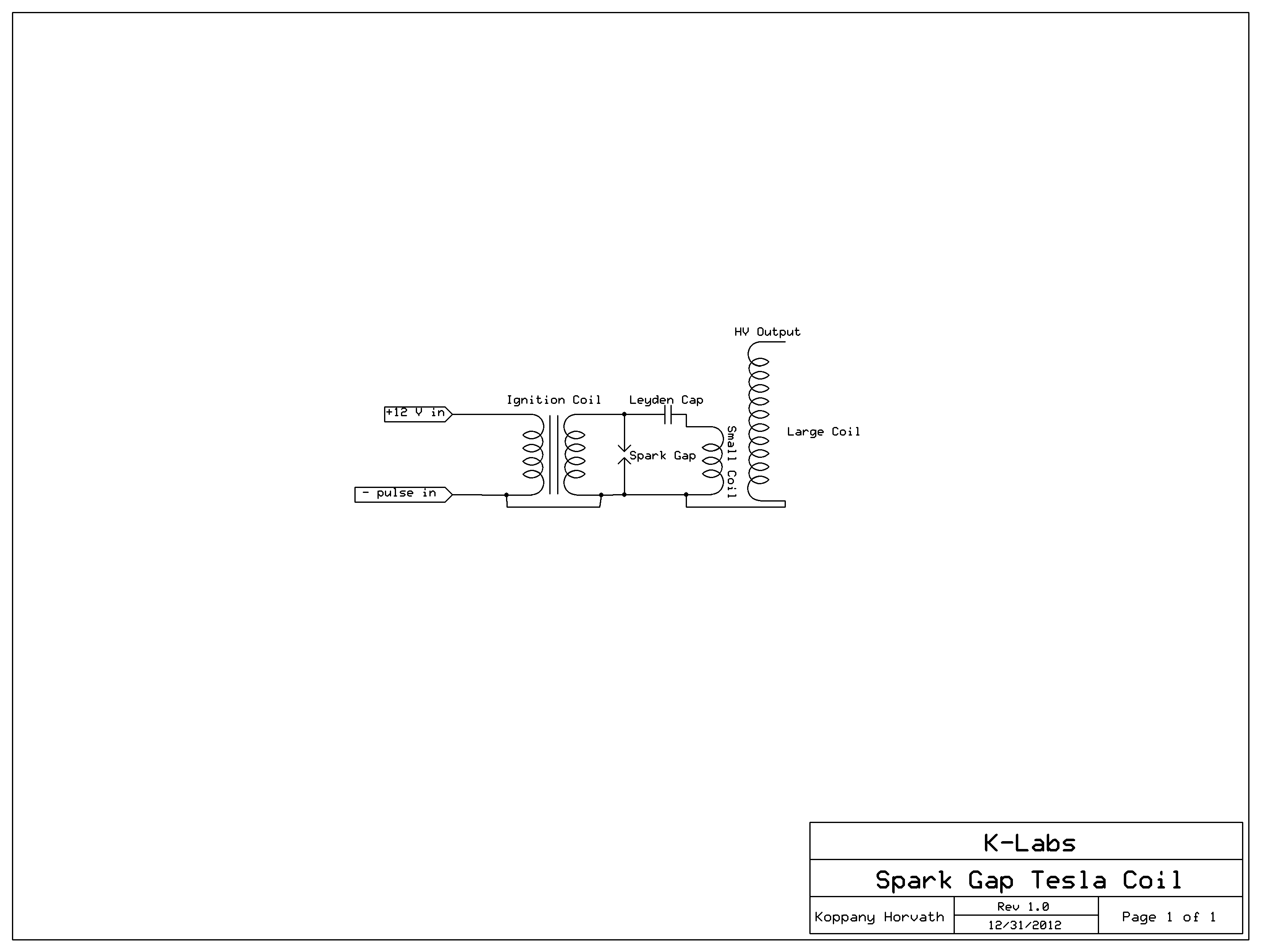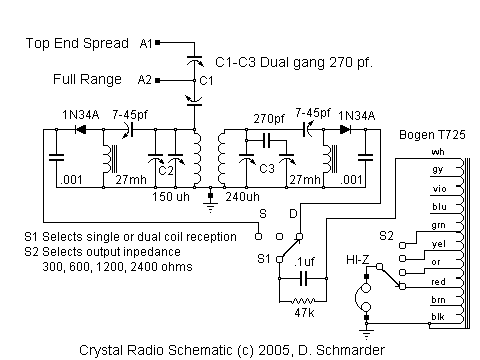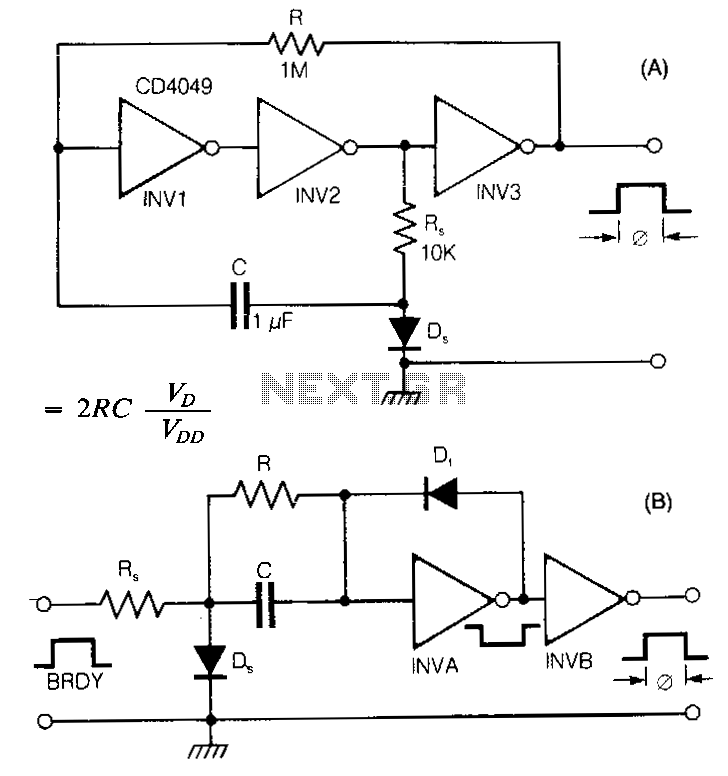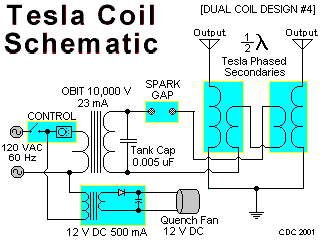
tesla coil

This circuit was designed to prevent damage to the 555 timer. It was observed that sharing a high voltage contact with a power connector for the ignition coil caused high voltages to return to the 555 timer, resulting in repeated failures (seven timers were damaged before achieving a working design). After desoldering several unused boards, it was discovered that most of the removed ICs were photocouplers, which could be utilized to isolate the frequency signal from the driver connected to the ignition coil, functioning similarly to a relay. While a Cosmo 1010 photocoupler was used due to its small size, other types could also be employed. The circuit allows for experimentation with capacitor and resistor values, which influence the arc length generated by the ignition coil. The ignition coil is not directly connected to the driver circuit but is indicated in the Tesla coil schematic. It is crucial that the 6-volt power source is distinct from the 12-volt source, necessitating the use of a photocoupler for complete isolation. An "audio in" port is available on pin 5 of the 555 timer; however, to utilize this feature, the capacitor must be changed from a 0.47 µF electrolytic to a 0.1 µF ceramic capacitor (marked 104). The audio device output should connect to this port, with the common wire linked to the negative side of the 6-volt source. Caution is advised against using expensive audio devices, as a low-cost CD player exhibited unusual behavior when connected. The circuit diagram provided represents the driver circuit alongside a transistor. The initial circuit is a basic spark gap Tesla coil without additional safety features or regulators. It is designed such that a grounding connection is not necessary at the base of the secondary coil, although it is recommended for safety. The middle circuit is a basic schematic of a solid-state Tesla coil sourced from ElectronsBeFree, which is an off-line Tesla coil. There is limited information online regarding this design, and it requires components such as IGBTs and high-power MOSFETs, which may be cost-prohibitive. The last circuit presented is a very simple solid-state Tesla coil, noted for its basic design. The final image showcases the overall setup. The Tesla coil operates in a solid-state manner due to the driver and the ability to modulate frequency with audio input. The ignition coil is a critical component in a non-solid-state Tesla coil, capable of generating several thousand volts. It provides the high voltage necessary for operation. The ignition coil typically has three connections, which necessitated the design of an isolated driver circuit to prevent inductive kickback from interfering with high voltage signals. The spark gap serves as a primary timing mechanism, controlling the capacitor discharge across the primary coil. However, it produces significant light and noise, complicating the use of the coil for audio playback.
The circuit design incorporates a 555 timer configured in astable mode, which generates a square wave output that drives the ignition coil. The photocoupler serves as an isolation barrier, ensuring that high voltage spikes do not affect the low voltage control circuitry. The choice of the photocoupler is flexible, allowing for various models that meet the required specifications.
The ignition coil is connected to the primary side of the Tesla coil circuit, where it transforms the low voltage input into high voltage output. The spark gap is positioned in parallel with the primary coil and is responsible for creating a discharge path for the energy stored in the capacitor. As the capacitor charges, once it reaches a certain voltage, it discharges through the spark gap, generating a high-voltage pulse that excites the secondary coil of the Tesla coil, producing electrical arcs.
For optimal performance, the circuit may require tuning of the capacitor and resistor values in the timing circuit to achieve the desired frequency and arc length. A variable resistor could be integrated to allow for real-time adjustments during operation. The optional audio input provides an interesting feature, enabling sound modulation through the Tesla coil, although care should be taken to avoid damage to sensitive audio equipment.
The isolation of the power sources is critical in preventing ground loops and ensuring the safety of the entire system. The schematic should clearly indicate all connections, including power supply inputs, output connections to the ignition coil, and the layout of the components for clarity. Proper heat dissipation measures should also be considered for components that may generate significant heat during operation. Overall, the design emphasizes safety, reliability, and flexibility for experimentation with various component values and configurations.This circuit was designed to not fry the 555 timer, this is because I noticed that having the ignition coil share a high voltage contact with a power connector made somewhat high voltages go back and into the 555 timer, thus frying it (I went through about 7 timers before I finally got this to work). So after desoldering a few unused boards, I fou nd out that most of the IC`s I removed were photocouplers and I thought that they could be used to isolate the frequency signal appart from the driver that connects to the ignition coil. In a way the photocoupler acted like a relay. For the photocoupler it does not have to be the cosmo 1010, I just used that one because that was the smallest photocoupler that I removed from the board.
You can play around with the capacitor and resistor values to see what they do, but I found that this combination gives some of the largest arcs from the igntion coil. The ignition coil is not portrayed as connected to the driver circuit, but it is shown clearly where to connect in the schematic of the tesla coil itself.
It is also essential that the 6 volt power source is separate from the 12 volt one, that is why there`s a photocoupler, to completely isolate it. You can see that there is an "audio in" port on pin 5 of the 555 timer, that is optional, but in order to use it, you will have to change the capacitor from a 0.
47uF electrolytic to a 0. 1uF ceramic capacitor (it`s the one with the number 104); all you have to do is connect the output of the audio device to this and connect the common wire to the negative on the 6 volt side, but try not to use anything expensive as I`ve been using a cheap CD player and it acts a bit weird now from being connected, so try not to use your $200 ipod touch or anything like that. The picture of a physical circuit is what the driver circuit looks like, and beside it is the transistor.
The first circuit is the one I used, a basic spark gap Tesla Coil with no additional safety features or regulators or anything. The circuit is wired in a way that you don`t need to have a grounding connection at the base of the secondary, it`s probably recomended but will make things harder and will pose a threat to any of your electronics that are plugged in.
The circuit in the middle is the most basic schematic of a solid state Tesla coil taken off electronsbefree, it is an off-line Tesla coil. I wanted to make one of these, but there isn`t very much information on the internet about this one, and it also involves components that are somewhat pricey and that I don`t currently have access to like IGBT`s and high power MOSFET`s.
The last circuit is a super simple solid state Tesla coil, it must be the most basic one I have ever seen, I think the owner of this image could be found here. I also wanted to make this one, but I don`t have the resources to buy a nice high power MOSFET and the IXYDD414 chip.
The last picture is what my setup looks like. But I got my Tesla coil pretty solid state-ish because of the driver and being able to modulate the frequency with audio. Ignition Coil: Probably the most necesary component in a non-sstc type Tesla coil, but it doesn`t have to be an ignition coil, just as long as it is something that can make a couple thousand volts.
This is the component that supplies the high voltage that is necesarry to drive the unit. If you`ve ever seen or used an ignition coil, you know that there is only 3 connections, which is why I had to design that isolated driver circuit so you don`t get inductive kickback mixed with high voltage signals. Spark Gap: This component is one of the main timing mechanisms. This controls when the capacitor discharges across the primary coil. A drawback of this component is that it creates a lot of light, like an arc lamp. Another drawback is that it is incredibly loud, so this complicated some things when it came to playing music off this coil.
To make this one, I just used 🔗 External reference
The circuit design incorporates a 555 timer configured in astable mode, which generates a square wave output that drives the ignition coil. The photocoupler serves as an isolation barrier, ensuring that high voltage spikes do not affect the low voltage control circuitry. The choice of the photocoupler is flexible, allowing for various models that meet the required specifications.
The ignition coil is connected to the primary side of the Tesla coil circuit, where it transforms the low voltage input into high voltage output. The spark gap is positioned in parallel with the primary coil and is responsible for creating a discharge path for the energy stored in the capacitor. As the capacitor charges, once it reaches a certain voltage, it discharges through the spark gap, generating a high-voltage pulse that excites the secondary coil of the Tesla coil, producing electrical arcs.
For optimal performance, the circuit may require tuning of the capacitor and resistor values in the timing circuit to achieve the desired frequency and arc length. A variable resistor could be integrated to allow for real-time adjustments during operation. The optional audio input provides an interesting feature, enabling sound modulation through the Tesla coil, although care should be taken to avoid damage to sensitive audio equipment.
The isolation of the power sources is critical in preventing ground loops and ensuring the safety of the entire system. The schematic should clearly indicate all connections, including power supply inputs, output connections to the ignition coil, and the layout of the components for clarity. Proper heat dissipation measures should also be considered for components that may generate significant heat during operation. Overall, the design emphasizes safety, reliability, and flexibility for experimentation with various component values and configurations.This circuit was designed to not fry the 555 timer, this is because I noticed that having the ignition coil share a high voltage contact with a power connector made somewhat high voltages go back and into the 555 timer, thus frying it (I went through about 7 timers before I finally got this to work). So after desoldering a few unused boards, I fou nd out that most of the IC`s I removed were photocouplers and I thought that they could be used to isolate the frequency signal appart from the driver that connects to the ignition coil. In a way the photocoupler acted like a relay. For the photocoupler it does not have to be the cosmo 1010, I just used that one because that was the smallest photocoupler that I removed from the board.
You can play around with the capacitor and resistor values to see what they do, but I found that this combination gives some of the largest arcs from the igntion coil. The ignition coil is not portrayed as connected to the driver circuit, but it is shown clearly where to connect in the schematic of the tesla coil itself.
It is also essential that the 6 volt power source is separate from the 12 volt one, that is why there`s a photocoupler, to completely isolate it. You can see that there is an "audio in" port on pin 5 of the 555 timer, that is optional, but in order to use it, you will have to change the capacitor from a 0.
47uF electrolytic to a 0. 1uF ceramic capacitor (it`s the one with the number 104); all you have to do is connect the output of the audio device to this and connect the common wire to the negative on the 6 volt side, but try not to use anything expensive as I`ve been using a cheap CD player and it acts a bit weird now from being connected, so try not to use your $200 ipod touch or anything like that. The picture of a physical circuit is what the driver circuit looks like, and beside it is the transistor.
The first circuit is the one I used, a basic spark gap Tesla Coil with no additional safety features or regulators or anything. The circuit is wired in a way that you don`t need to have a grounding connection at the base of the secondary, it`s probably recomended but will make things harder and will pose a threat to any of your electronics that are plugged in.
The circuit in the middle is the most basic schematic of a solid state Tesla coil taken off electronsbefree, it is an off-line Tesla coil. I wanted to make one of these, but there isn`t very much information on the internet about this one, and it also involves components that are somewhat pricey and that I don`t currently have access to like IGBT`s and high power MOSFET`s.
The last circuit is a super simple solid state Tesla coil, it must be the most basic one I have ever seen, I think the owner of this image could be found here. I also wanted to make this one, but I don`t have the resources to buy a nice high power MOSFET and the IXYDD414 chip.
The last picture is what my setup looks like. But I got my Tesla coil pretty solid state-ish because of the driver and being able to modulate the frequency with audio. Ignition Coil: Probably the most necesary component in a non-sstc type Tesla coil, but it doesn`t have to be an ignition coil, just as long as it is something that can make a couple thousand volts.
This is the component that supplies the high voltage that is necesarry to drive the unit. If you`ve ever seen or used an ignition coil, you know that there is only 3 connections, which is why I had to design that isolated driver circuit so you don`t get inductive kickback mixed with high voltage signals. Spark Gap: This component is one of the main timing mechanisms. This controls when the capacitor discharges across the primary coil. A drawback of this component is that it creates a lot of light, like an arc lamp. Another drawback is that it is incredibly loud, so this complicated some things when it came to playing music off this coil.
To make this one, I just used 🔗 External reference




